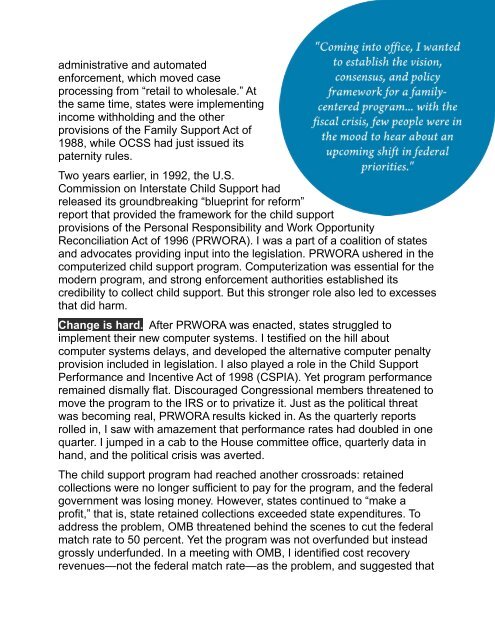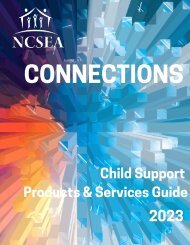April 2024 CSQ
Create successful ePaper yourself
Turn your PDF publications into a flip-book with our unique Google optimized e-Paper software.
administrative and automated<br />
enforcement, which moved case<br />
processing from “retail to wholesale.” At<br />
the same time, states were implementing<br />
income withholding and the other<br />
provisions of the Family Support Act of<br />
1988, while OCSS had just issued its<br />
paternity rules.<br />
Two years earlier, in 1992, the U.S.<br />
Commission on Interstate Child Support had<br />
released its groundbreaking “blueprint for reform”<br />
report that provided the framework for the child support<br />
provisions of the Personal Responsibility and Work Opportunity<br />
Reconciliation Act of 1996 (PRWORA). I was a part of a coalition of states<br />
and advocates providing input into the legislation. PRWORA ushered in the<br />
computerized child support program. Computerization was essential for the<br />
modern program, and strong enforcement authorities established its<br />
credibility to collect child support. But this stronger role also led to excesses<br />
that did harm.<br />
Change is hard. After PRWORA was enacted, states struggled to<br />
implement their new computer systems. I testified on the hill about<br />
computer systems delays, and developed the alternative computer penalty<br />
provision included in legislation. I also played a role in the Child Support<br />
Performance and Incentive Act of 1998 (CSPIA). Yet program performance<br />
remained dismally flat. Discouraged Congressional members threatened to<br />
move the program to the IRS or to privatize it. Just as the political threat<br />
was becoming real, PRWORA results kicked in. As the quarterly reports<br />
rolled in, I saw with amazement that performance rates had doubled in one<br />
quarter. I jumped in a cab to the House committee office, quarterly data in<br />
hand, and the political crisis was averted.<br />
The child support program had reached another crossroads: retained<br />
collections were no longer sufficient to pay for the program, and the federal<br />
government was losing money. However, states continued to “make a<br />
profit,” that is, state retained collections exceeded state expenditures. To<br />
address the problem, OMB threatened behind the scenes to cut the federal<br />
match rate to 50 percent. Yet the program was not overfunded but instead<br />
grossly underfunded. In a meeting with OMB, I identified cost recovery<br />
revenues—not the federal match rate—as the problem, and suggested that















